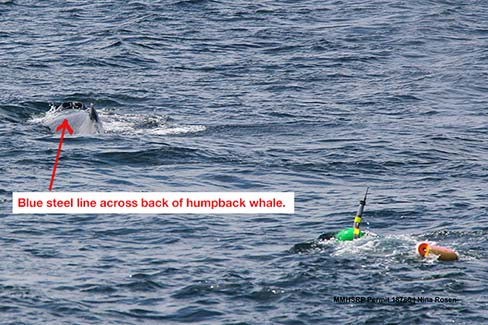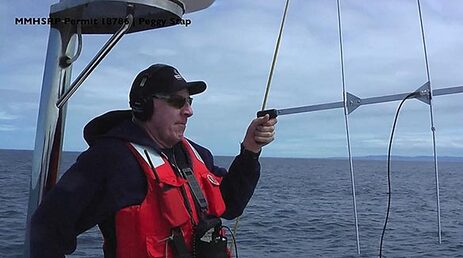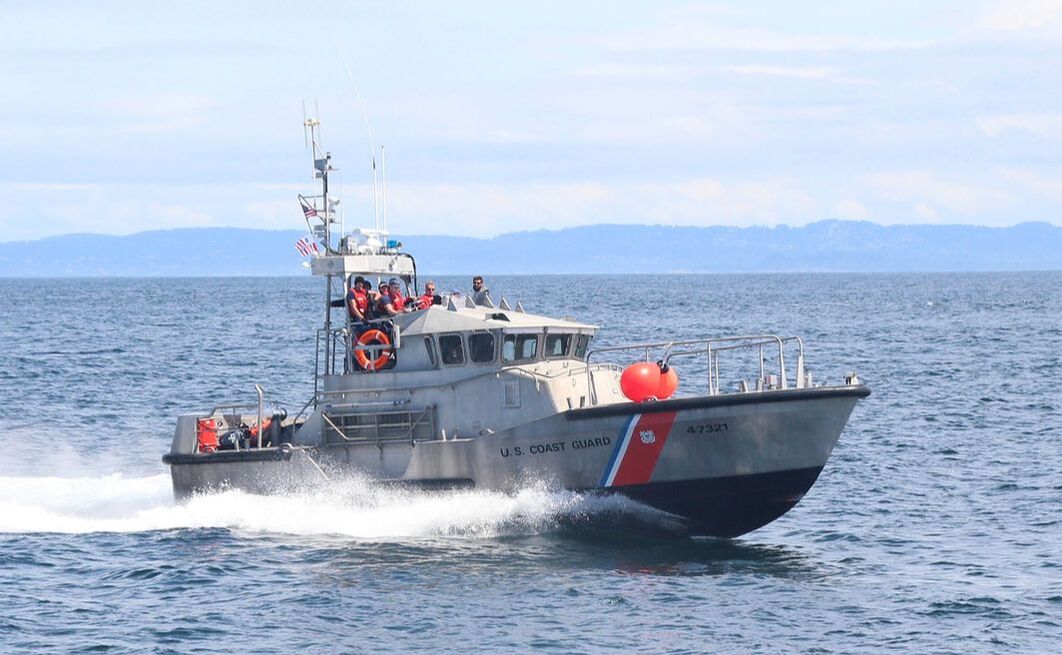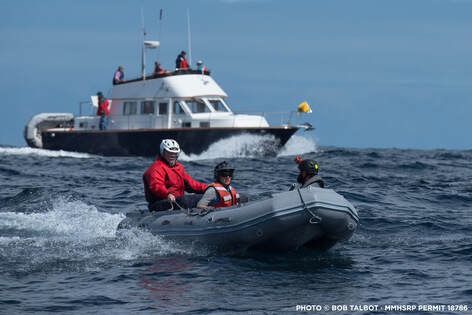Subadult humpback whale first reported late Wednesday morning, April 20th, by John Favazza of FV Okie Dokie who immediately reported the distressed whale and stayed with the whale until the response team arrived. John's efforts led to this whale being rescued.
|
On Wednesday, April 20th, Kate Spencer, captain of Fast Raft Safaris, went out to relieve John Favazza and continued to stand by until JD Douglas, with Moss Landing Marine Labs, took Scott Benson and Karin Forney (both with NOAA) out to the whale in the ZHT rib to location where Kate was standing by with the whale. They were able to attach the telemetry buoy to the existing gear trailing behind the humpback.
|
Later, Pieter Folkens, with Alaska Whale Foundation, and Ryan Berger, with Point Blue Conservation, along with Scott and Karin were ferried out by Kate Spencer of Fast Raft Safaris. They were able to wrap and bundle 100' of the trailing line to shorten it and did some underwater video to assess the entanglement. It was too late to remove the gear so a response was planned for the next day. They found the whale that evening with the 3-element antenna that picks up the VHF signal from the telemetry package on the telemetry buoy.
|
Vertical Divider
|
On Thursday, April 21st, Marine Life Studies' Whale Entanglement Team (WET)℠ crew, aboard their Whale Rescue Research Vessel, departed Moss Landing to search for the whale which had traveled south overnight off the Big Sur coastline.
|
The crew included Doug Ross, Nina Rosen, Steve Baltes, Peggy Stap, and Wally Smith (with the USCG Coast Guard Auxillary). We had the position from the satellite buoy but once in the area were able to relocate the whale using the 3-element antenna held by Doug Ross as seen in the photo above. We located the whale at 11:35 and stood by until the rest of the team, led by Ryan Berger, arrived on scene aboard the United States Coast Guard vessel at 12:13. Bob Talbot, of Talbot Films, joined us at 13:04 to aid with the response.
Aboard the USCG 47MLB (pictured on right) were Ryan Berger, Karin Forney, Scott Benson, Kathi Koontz, with Oceanic Society, and Donn Trenner, one of our WET℠ volunteers. Once on scene they inflated the hypalon roll-up boat and attached the motor that was purchased through a grant that Marine Life Studies received from the International Fund of Animal Welfare. The USCG 47 MLB crew were Chris, Willard, and Joshua.
Aboard the USCG 47MLB (pictured on right) were Ryan Berger, Karin Forney, Scott Benson, Kathi Koontz, with Oceanic Society, and Donn Trenner, one of our WET℠ volunteers. Once on scene they inflated the hypalon roll-up boat and attached the motor that was purchased through a grant that Marine Life Studies received from the International Fund of Animal Welfare. The USCG 47 MLB crew were Chris, Willard, and Joshua.
Once the inflatable was deployed the cutting crew, Ryan, Scott, and Kathi, approached the whale to do some more underwater assessment. Then they returned to our boat to view the footage and made a plan of what lines to cut to release the gear. Bob ferried Karin and Donn from the USCG 47 MLB to our boat.
Ryan, Scott, and Kathi boarded the hypalon roll-up boat again with the proper cutting tools to approach the whale and make the two cuts that successfully freed the whale. Very exciting for us all to see the whale swim off free of all the entanglement gear.
It was a great effort of so many people that made the rescue of this humpback whale possible:
- Alaska Whale Foundation
- Fast Raft Safaris
- Marine Life Studies' Whale Entanglement Team (WET)℠
- Moss Landing Marine Labortories
- NOAA Southwest Fisheries Science Center
- Oceanic Society
- Point Blue Conservation Science
- Talbot Films
- United States Coast Guard
All of the above are part of the CWR network. All photos are taken under NOAA's Marine Mammal Health and Stranding Response Program (MMHSRP) Permit 18786.
The biggest thanks goes to John Favazza of FV Okie Dokie. His role was key to the whole operation to rescue the entangled humpback.
Ryan, Scott, and Kathi boarded the hypalon roll-up boat again with the proper cutting tools to approach the whale and make the two cuts that successfully freed the whale. Very exciting for us all to see the whale swim off free of all the entanglement gear.
It was a great effort of so many people that made the rescue of this humpback whale possible:
- Alaska Whale Foundation
- Fast Raft Safaris
- Marine Life Studies' Whale Entanglement Team (WET)℠
- Moss Landing Marine Labortories
- NOAA Southwest Fisheries Science Center
- Oceanic Society
- Point Blue Conservation Science
- Talbot Films
- United States Coast Guard
All of the above are part of the CWR network. All photos are taken under NOAA's Marine Mammal Health and Stranding Response Program (MMHSRP) Permit 18786.
The biggest thanks goes to John Favazza of FV Okie Dokie. His role was key to the whole operation to rescue the entangled humpback.
How you can help if you see an entangled whale:
Report immediately, call 877-SOS-WHALE (877-767-9425) or hail the U.S. Coast Guard on VHF CH-16.
If possible, please stay with the animal while maintaining 100 yards distance from the animal. Authorized personnel will guide you as what to do next.
If possible, please stay with the animal while maintaining 100 yards distance from the animal. Authorized personnel will guide you as what to do next.
Provide the following information to help authorized responders:
All photos are copyrighted. Photos taken under the MMHSRP Permit. The Whale Entanglement Team (WET)® is part of the West Coast Large Whale Entanglement Response Network.
Learn more about WET® and how you can help.
- Note the nature of the entanglement, location of the entanglement on the whale's body (i.e. a blue line wrapped around the tail (fluke) and wrapped around body by dorsal fin, description of the gear trailing (i.e. buoys if any and the number and color of the buoys, line or other gear trailing with approximate distance behind the whale the gear is trailing).
- Relay the whale's exact location (be as specific as possible, include latitude and longitude if available). Did you know you can get your exact location with your smart phone. Click to learn how.
- Other details such as is the animal swimming (speed and direction the animal is heading, is it diving or staying on the surface, is it breathing). One of the important keys to the success of freeing a whale from a life-threatening entanglement is to have someone standing by until one of our Whale Entanglement Team members arrives.
- If you are able, while maintaining 100 yards from the whale, please take high-resolution photographs of the whale including: the right and left side of the animal including the dorsal fin, the head and back on both sides, the area between the dorsal fin and the fluke (tail), the underside of the fluke if the animal is diving (if it dives it will raise its fluke vertically above the water and the underside of that fluke is a unique pattern that we can identify individual animals, like a human fingerprint), and any trailing gear or buoys.
All photos are copyrighted. Photos taken under the MMHSRP Permit. The Whale Entanglement Team (WET)® is part of the West Coast Large Whale Entanglement Response Network.
Learn more about WET® and how you can help.







